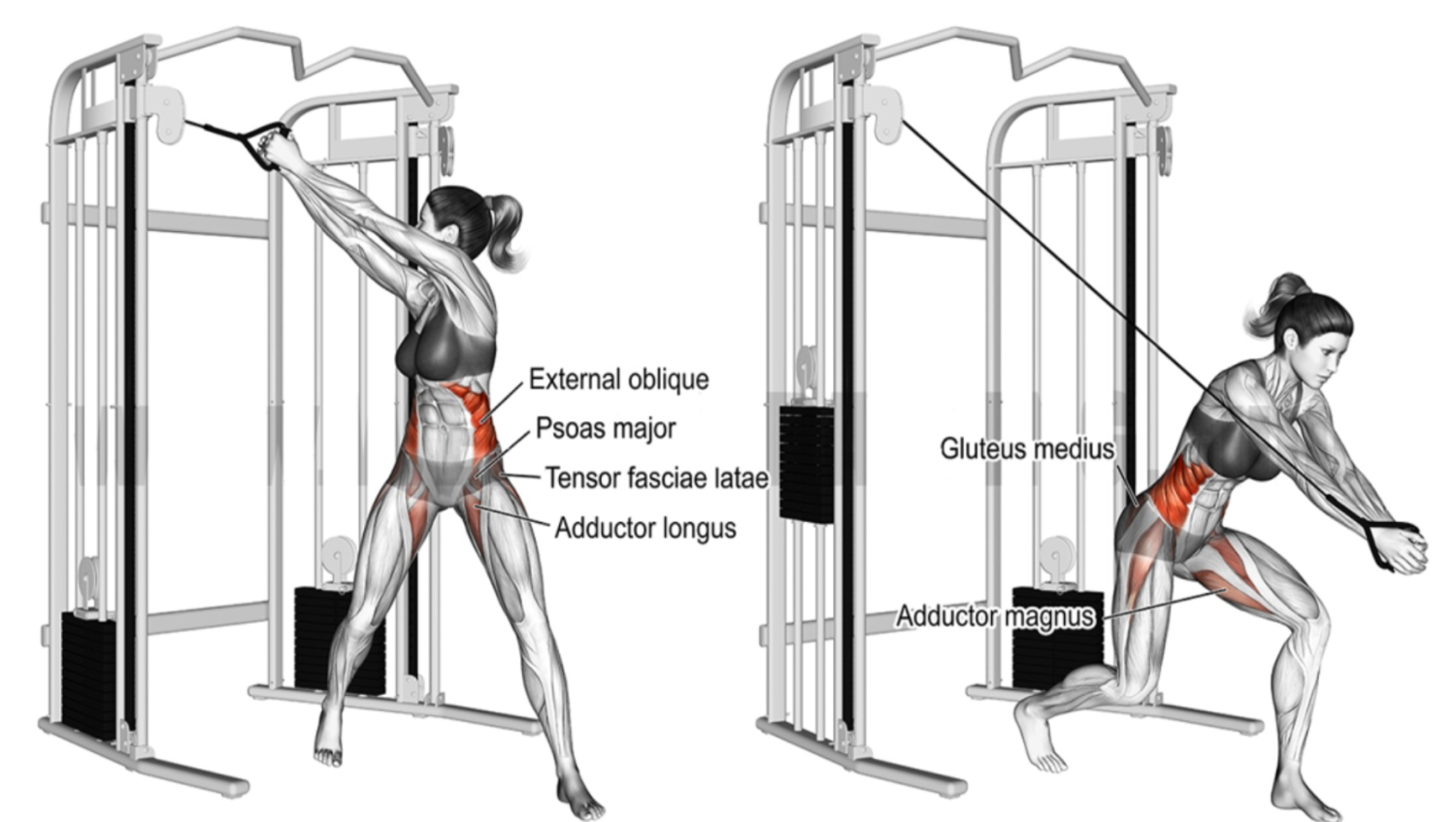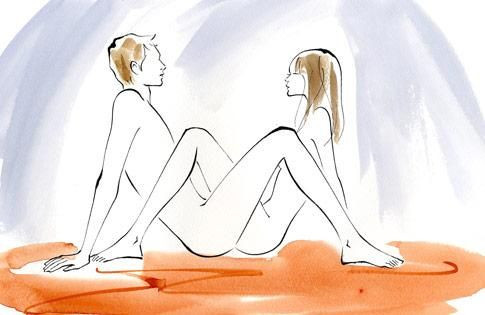Effective Abs & Oblique Cable Exercises & Workout

In order to build the impressive six-pack abs, we first need to understand the anatomy and function of the abs, which helps to perform the cable ab exercises at the highest level.
Cable machines are the best way to train your abs. They deliver constant tension to your abs and upper body.
By increasing the weight stack, you can also gradually overload your abs and oblique muscles.
There are two muscle groups in your waist: the rectus abdominis (your "six-pack" muscles) and the obliques.
We usually refer to our abs as the rectus abdominis ("abdominal muscle").
Muscles of the abdomen and obliques
From the lower margin of the rib cage and sternum, the Rectus abdominis muscle attaches vertically to the pubic bone.

Located between the lower ribs and the pelvis, the external oblique is the outer visible layer of the rectus abdominis.
Under the external obliques, the internal obliques run into the lower back.
Transversus abdominis, which lies horizontally across the abdominal wall, is the deepest part of the abdominals.
With a cable machine, you can train your abs and core
To train your abs and core muscles, the cable machine core workout may be the most versatile and user-friendly workout in the gym.
Unlike bodyweight abdominal exercises, cable ab & oblique workouts will have consistent time under tension, resulting in more muscle activation and better strength and development. Moreover, you will have greater range of motion with many exercises too, which is vital for strength and hypertrophy.
The abs and oblique, in particular, benefit from its use in that it progressively increases strength and variety.
By manipulating the motion of the cable, you can add resistance to virtually any natural bodily mechanic, which means you can work your core throughout the entire workout.
Cable Machine Benefits During Abs Workout
We will take a look at some other benefits of ab and oblique exercises performed with a cable machine in addition to training the core.
- A cable ab and oblique workout is more evenly distributed, and you have a constant load on your core muscles throughout.
- Cable ab and oblique exercises offer almost unmatched versatility because you can easily change up the load, angle, grip positioning and body positioning.
- You can maximize muscle growth by using the cable setup, which gives your muscles almost uninterrupted time under tension.
- Cable ab training has the benefit of being safer than free weight exercises. Cables protect you from injuries caused by dumbbells and barbells.
- Cable core workouts offer a smooth, controlled motion that can be adjusted based on the variables above to deliver the exact resistance.
- Different parts of the core muscles can be worked out depending on the position of the body and the direction of the cable.
Here are 18 of the best cable exercises for abs and obliques
The exercises below target your core from all angles and offer a range of twisting, kneeling, and standing motions.
Your abs and obliques need to be worked equally with a variety of exercises.
Cable crunches while kneeling
Cable cunches are a great starter exercise if you're looking for straightforward cable ab exercises.
Known also as kneeling cable crunches, cable crunches target your abdominal muscles. With cable crunches, you can increase resistance and train to failure.
To get big and carved abs, your fast-twitch muscle fibers need a workout that emphasizes strength and hypertrophy.

How To Do Kneeling Cable Crunch
- Place your wrists against the sides of your head while kneeling in front of a high pulley. Grasp the rope attachment in each hand.
- Flex your hips, but allow the rope's weight to lift your upper torso so that your lower back is extended.
- Pull the rope downward by flexing your abdomen while keeping your hips fixed.
- Let the rope lift your upper torso so that your lower back is extended again. Hold for two counts. Relax your abdomen.
Tips
- Maintain a neutral position for your neck.
- It is important to keep your hips fixed. All movements should be made in your abdomen.
- Choose a weight that does not put too much strain on your lower back.
Bending on the cable side
In addition to strengthening the core muscle and targeting the obliques, the cable side bend improves the lower back and hip stability.
The cable side bend is simply a variation of the dumbbell side bend. You can change the point at which the load is maximized by using cables.

How To Do Cable Side Bend
- Stand side-on to the weight stack while attaching a D-handle to a low pulley.
- Your right hand should be holding the D-handle, and your right elbow should be straight and close to your body. Your torso should be laterally flexed (bent sideways) towards the pulley.
- Pull the D-handle upward while bending your torso away from the pulley.
- By bending your torso towards the pulley, slowly lower the D-handle back to its starting position.
- Turn around and repeat the cable side bend with your left side for the desired number of repetitions.
Tips
- Throughout the exercise, keep your hips still and your arm close to your body.
- To work the obliques, perform this exercise slowly and steadily.
Pallof Press
Exercises like the Pallof Press can increase overall stability and activate a variety of large muscle groups.
You will develop a stable core by performing this anti-rotation hold exercise.
As a movement prep and core strengthening exercise, the Pallof press helps maintain proper spinal alignment and increase core strength.

How To Do Pallof Press
- Standing on a side cable machine with your feet hip-width apart, attach a handle to a chest-high cable pulley.
- Put your free hand over the hand holding the handle, and grasp the handle with the hand nearest the pulley.
- Put both hands on the handle and extend your arms in front of your chest while engaging your core.
- After holding this position for five to ten seconds, bring the handle back in to your chest while resisting the cable's pull.
- On the opposite side, repeat the exercise.
Tips
- Throughout the exercise, keep your chest forward and your back straight.
- Maintain a straight body position while lifting a challenging weight.
Twisting a cable
A cable twist isolates the oblique muscles of the core.
In addition to strengthening the core muscles, it is a functional exercise because it is performed on the feet.

How To Do Cable Twist
- Handle a cable pulley at shoulder height. Hold it with both hands, either interlacing your fingers or holding it one hand over the other. Stand shoulder-width apart from the machine.
- Pull the handle across your body until your torso faces away from the pulley while keeping your arms straight.
- Slowly reverse the movement to return to the starting position after holding for two counts.
- Repeat the exercise on the opposite side for the prescribed number of repetitions.
Tips
- Make sure your arms are straight and your shoulders are locked.
- Allow your hips and knees to rotate slightly, instead of locking them.
- Maintain a constant weight.
Chop of cable wood
You should add these oblique workouts to your core exercises arsenal, also known as the cable up-down twist and the cable woodchopper.
It strengthens your torso's twisting movement pattern and improves your torso's ability to resist twisting forces.

How To Do Cable Wood Chop
- Handle the cable pulley with both hands, either interlacing your fingers or holding it with one hand over the other. Stand near the machine with your feet shoulder-width apart.
- By keeping your arms straight, pull the handle diagonally downward until your hands are knee height and your torso faces away from the pulley.
- Hold for a count of two, then slowly reverse the movement.
- Repeat the exercise on your opposite side for the prescribed number of repetitions.
Tips
- Hold the handle for a few seconds halfway through some reps to force your body to resist twisting.
- Allow the hips and knees to rotate slightly instead of locking them.
- Make sure your arms are straight and your shoulders are locked.
- Keep the weight under control at all times.
The cable down-up twist (Low to High Wood Chop)
Cable down up twist is also known as cable wood chop.
This exercise targets the muscles of the abdominal complex and is a variation of the wood chop.

How To Do Cable Down-Up Twist
- Hold the handle with both hands, either with your fingers intertwined or with one hand over the other. Stand next to the machine with your feet shoulder-width apart.
- Pull the handle diagonally upward while keeping your arms straight.
- Hold for two counts, then slowly reverse the movement to return to the starting point.
- Repeat the exercise on your opposite side for the prescribed number of repetitions.
Tips
- Halfway through some reps, hold the stirrup for a few seconds to force your body to resist twisting.
- Allow your hips and knees to rotate a little.
- Make sure your arms are straight and your shoulders are locked.
Crunch of standing cables
Another great exercise for cable abs is the standing cable crunch.
Unlike the kneeling cable crunches, the standing cable crunch is harder since you are standing and have less stability.

How To Do Standing Cable Crunch
- Select an appropriate weight and attach a rope to a high pulley.
- With your back to the machine, hold one side of the rope attachment in each hand
- With your elbows tucked in and hands by your ears, place the rope behind your head
- Pull your elbows towards your thighs while engaging your core and performing a crunch
- Before returning to the starting position, hold the peak contraction for a moment.
Tips
- Maintain a neutral position for your neck.
- Your hips should remain fixed. Only your abdomen should move.
- You shouldn't choose a weight that will put most of the strain on your lower back.
Oblique crunches while standing
You can correct potential imbalances by adding single-arm exercises to an abs workout using a cable machine.
As part of your Cable abs workout regimen, you may incorporate standing oblique crunches, also known as side crunches, to target your oblique muscles.
How To Do Standing Oblique Crunches
- Stand side-on to the weight stack and attach a D-handle to a high pulley.
- Make sure that your forearm is at a 90-degree angle to your upper arm and both feet are firmly placed on the floor at shoulder width while holding the D-handle with your left hand.
- Pull the weight down as far as you can with your left oblique muscle while keeping your back straight.
- Return to your original position after a brief pause.
- Turn around and repeat the cable side bend with your left side for the desired number of repetitions.
Tips
- Pull the weight down as far as you can using your left oblique muscle.
- If you bend too far down during the crunch, you could cause an injury. This is not necessary for the exercise to be effective.
Reverse cable crunch
It is a challenging exercise that primarily targets your rectus abdominis, the muscle in your abdomen that makes up your "six-pack".
Cable reverse crunches are an intermediate-level variation of the popular abdominal crunches.
How To Do Cable Reverse Crunch
- An ankle strap should be attached to the cable machine's bottom.
- Face up on the floor with your hands extended at your sides.
- Lift your hips and glutes off the floor while bringing your knees toward your chest.
- Maintain a bend in your knees throughout the movement.
- Reverse the motion by slowly lowering your legs back to the starting position. Repeat for the desired number of repetitions.
Tips
- Do not use momentum when moving. Keep the movement slow and controlled.
- Perform this exercise on a decline bench with your head on top.
Twist on the floor with cable seated
As an alternative to a bench, this seated twist is just as effective, but may require more balance with your feet out in front rather than under you.
Cable Seated Twist on the Floor
- Put the pulley at shoulder height and sit on the floor with your feet flat on the ground.
- Hold the stirrup with both hands as you twist your torso.
- Pull the cable taut and straighten your torso and arms. Your arms should be parallel to the floor.
- Rotate your torso slowly to the opposite side while keeping your arms straight.
- After two counts, reverse the motion and return to the starting point.
- Repeat the exercise on the opposite side for the prescribed number of repetitions.
Tips
- Make sure your torso and arms are straight and your movements are controlled.
- Twist from one side to the other, and then back again, to get a full range of motion.
Reverse cable tuck
Try the Cable Tuck Reverse Crunch if you want to get creative with your cable ab exercises.
It is an advanced movement that targets both your upper and lower abdominals simultaneously.
For the cable tuck crunch, you will need both sides of the cable machine/a twin tower.
How To Do Cable Tuck Reverse Crunch
- An ankle strap attachment should be connected to a low pulley cable.
- Place an ankle strap around your ankle and hold a rope in your hands while lying on the floor.
- Your legs should be aligned with the cable. Raise your legs and bend your knees at a 90-degree angle.
- Elevate your hips off the ground as you bring your knees and hands inward to your torso.
- In a slow and controlled manner, drop your hips and bring your legs back to the starting 90-degree angle.
- You can repeat this as many times as you like.
Russian twist on cable
For functional fitness, the cable Russian twist on a stability ball strengthens your obliques and your spine's rotational movement pattern.
Tone your abs and obliques and trim your waist with this exercise.
You can improve your balance, stability, and posture by doing the Cable Russian twist.
How To Do Cable Russian Twist
- The cable pulley should be high enough so that you can fully extend your arms and the pulley is in line with your fists or higher.
- Your chest should be in line with the pulley when you lie on the ball next to the pulley.
- Put your closest hand on the handle, extend your arm directly over your chest, and place your other hand on top.
- You should keep your hips high, tighten your midsection, and rotate away from the machine using your core muscles. Your arms should remain straight and extended throughout the exercise.
- Slowly return to the starting position, resisting the weight's pull.
- Repeat on the other side after completing the desired number of reps.
Tips
- Throughout the exercise, keep your hips facing upward.
- Target the muscles with a slow, controlled motion.
Standing row of cable twisting
Cable Twisting Standing Row is another good single-arm cable ab exercise.
It involves numerous muscles as it requires you to slightly rotate at the waist. Since this is a unilateral exercise, your core will have to engage throughout the movement. Along with working your back, this exercise also works your hips, glutes, and other lower body muscles.
Standing Row Cable Twisting
- An elbow-high cable pulley should be attached to a single grip handle.
- Then step back into a staggered stance with your knees slightly bent and your arm straight out. Rotate your waist toward the cable.
- Pull your elbow back towards your waist while rotating your waist in the same direction.
- Repeat desired reps by pausing briefly at the top of the movement, then slowly returning to the starting position.
Tips
- Put your inactive hand on your other hip to add additional stability. Rotate your waist, not your hips.
- Slow and controlled reps are the key to making the most of this move.
Pulling a cable with one arm bent over
A bent-over one-arm cable pull builds strength and muscle in the latissimus dorsi and core muscles.
If you want to effectively stimulate the muscle by feeling it contract during every repetition, you should stick with moderate weights.
Bent-Over One-Arm Cable Pull
- Stand back with a wide, staggered stance while holding the handle of a waist-high cable pulley.
- Stretch your arm and shoulder forward as you bend your hips and knees until your torso is horizontal.
- Pull the stirrup to the side of your chest while keeping your elbow close to your body.
- As you hold for a count of two, squeeze your back muscles. Inhale as you reverse the motion and return the stirrup to the starting position.
- To complete the set, repeat the exercise on your right side for the desired number of repetitions, then switch arms for the next set.
Tips
- Since this is an isolation exercise, use moderate weights to effectively target the lats.
- Slow, controlled reps are key to getting the most out of this move.
- Concentrate on your back muscles doing the majority of the work. Go through your full range of motion.
Overhead cable twisting press
Lastly, if you're looking for a cable ab and oblique exercise, try the Cable Twisting Overhead Press.
A twisting cable overhead press is a great exercise for developing unilateral upper-body strength, as well as improving your balance, strength, and stability.
Overhead Press Cable Twisting
- Grab a stirrup (handle) with one hand and attach it to a low or waist-high pulley.
- With your elbows flexed and tucked in, spread your legs and squat a little, keeping your torso upright. Position the stirrup next to your body.
- Press the stirrup diagonally upward and away from the pulley as you straighten your legs and twist your body.
- Inhale as you reverse the motion and return your body and stirrup to the starting position. Hold for two counts.
- Replicate the exercise with your opposite arm after completing the desired number of reps with your right arm.
Tips
- Place your free hand on your hip and squat as deep as you like.
- Additionally, this exercise can only be performed with one arm at a time.
Crunch of seated cables
As an alternative to kneeling crunches, the cable seated crunch is equally effective.
How To Do Seated Cable Crunch
- Attach a rope to a high pulley and choose an appropriate weight while sitting on a flat bench with your back facing the pulley.
- Attachment for cable ropes
- With your hips still, perform a crunch with your abs while holding the rope behind your head.
- Pull your elbows towards your thighs while engaging your core
- Before returning to your starting position, hold the peak contraction for a moment.
- Replicate for the desired number of times.
Tips
- Ensure that your neck is in a neutral position.
- It's important to keep your hips fixed. Your entire movement should come from your abdomen.
- Make sure you don't choose a weight so heavy that your lower back has to handle most of the resistance.
Cable seated ab twist
Situated cable twists are also known as seated oblique twists.
By sitting on a stability ball instead of a bench, you will force more stabilizer muscles to be recruited, but you will not be able to lift as much weight.
Cable Seated Ab Twist Instructions
- Straddle the bench with your feet flat on the ground and adjust the pulley to shoulder height.
- Grab the stirrup with both hands while twisting your torso.
- Straighten your torso and arms. Make sure that your arms are parallel to the floor and that the cable is taut.
- Slowly rotate your torso to the opposite side while keeping your arms straight.
- After two counts, reverse the motion and return to the starting position.
- Repeat on the opposite side for the prescribed number of repetitions.
Tips
- Straighten your torso and arms and control your movement.
- Twist from one side to the other, and then back again, ensuring you get a full range of motion.
Crunch on the cable side of the Bosu ball
With the Bosu ball, you'll add balance to your workout. The Bosu ball is an excellent tool for strengthening your core compression.
Try this exercise if you want to get more creative with your cable ab exercises?
Bosu Ball Cable Side Crunch
- On a low setting, attach a single-grip handle to both sides.
- Position yourself in front of the machine using a Bosu Ball.
- Your butt should be close to the floor, but not touching it, with your small of your back arched around the ball.
- The hands should both have cables. Stand with your feet wide and your arms straight out in front of you.
- Keeping your arms straight, elevate your torso in a crunching motion without bending or dropping them.
- Alternate crunching to one side and the other until desired reps are reached.
Samples of cable workout plans
You could use them as a finisher, cycle between two or three moves with minimal rest in between, or you could train your core separately. The result will be a stronger, more stable core that is ready for action both inside and outside of the gym. Below are some sample workout plans for training your core, abs, and obliques separately with cable.
Workout plan for cable abs
- Kneeling Cable Crunch: 3 sets x 10-15 reps
- Cable Reverse Crunch: 3 sets x 10-15 reps
- Pallof Press: 3 sets x 8-12 reps
- Cable Tuck Reverse Crunch: 2-3 sets x 8-12 reps
- Cable Twisting Overhead Press: 2 sets x 10-12 reps
Workout plan for cable oblique
- Cable Side Bend: 3 sets x 10-15 reps
- Cable Russian Twist: 3 sets x 8-10 reps
- Cable Wood Chop: 3 sets x 8-12 reps
- Standing Oblique Crunches: 2 sets x 10-15 reps
Workout plan for the cable core
- Pallof Press: 3 sets x 10-15 reps
- Standing Cable Crunch: 1 set x 60 seconds
- Cable Twisting Standing Row: 3 sets x max reps
- Cable Twisting Overhead Press: 3 sets x 8-12 reps
- Cable Seated Ab Twist: 2 sets x 10-15 reps
For a well-rounded abs and core workout, you should mix it up with bodyweight exercises. If you want a well-rounded abs and core workout, then add variation.
After you have achieved sufficient core strength to safely and correctly perform ab rollouts and hanging leg raises, we strongly recommend adding them to your routine.
Frequently Asked Questions
Can cable machines help you lose weight?
Training your abs with a cable at the gym can help to build strong abdominal muscles. Strong abdominal muscles can also help reduce back pain and increase flexibility.
Is there a cable workout that is best for abs?
The above-mentioned cable machine abs exercises are a great way to start building six-pack abs if you hit the gym. Choose 3-4 exercises from the list above and do 3-4 sets of each to tone your oblique muscles. Remember that you should never train your oblique muscles more than three times per week.
On a cable machine, how do you lose belly fat?
Using a weight that makes 8 to 10 repetitions feel hard is the best way to lose extra subcutaneous fat around your waist. You can add variation to your workout by using cable, dumbbell, and barbell. Perform three sets of each exercise you include in your workout regime. And include cardio exercises.
Also, you should limit sugary foods, make 25 to 30 percent of your daily calories from sugars, and eat a healthy fat to lose belly fat.
Slimming your waist with cable abs workouts?
As fat does not convert to muscle, abs and oblique cable exercises alone will not reduce waist size.
In terms of fat loss and a slimmer waistline, a combination of aerobic exercise and ab cable workouts will probably produce the best results.
Takeaways
The development of power and strength in the upper and lower body can be improved more effectively when resistance exercises such as cable training are combined with free weight exercises. Your journey to getting thick and shaped six-pack abs will be accelerated if you combine cable machine ab workouts with dumbbell ab exercises and weight plate ab exercises.









